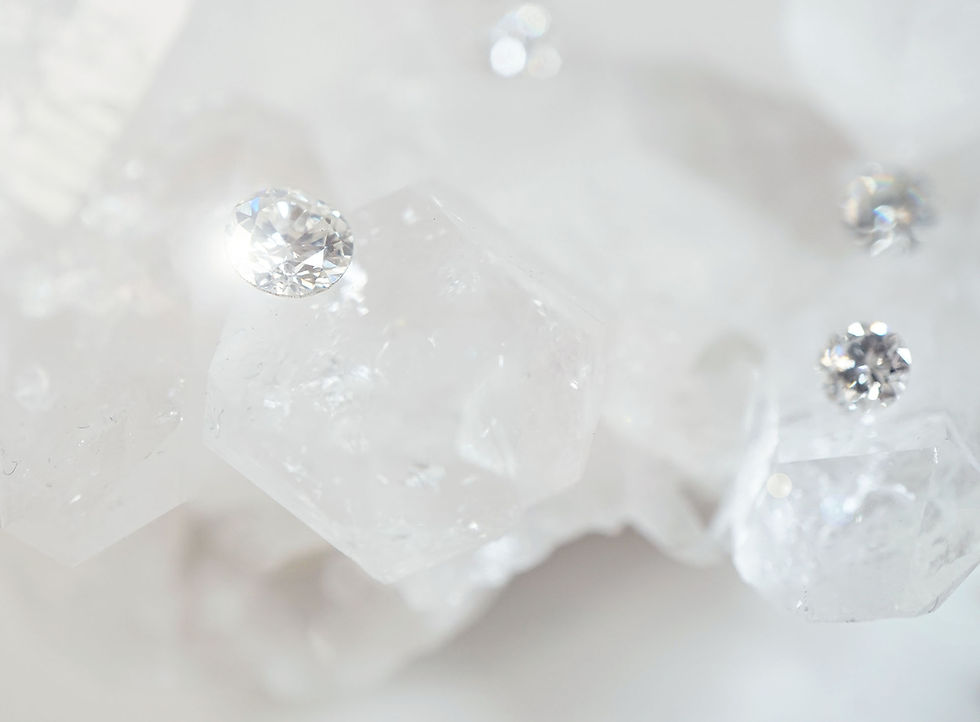A Brilliant Debate
- abqgoldandsilver
- Mar 22, 2024
- 3 min read

Diamonds have long been a source for our imaginations, symbolizing love, eternity, and luxury. With the increase of lab-grown diamonds, it has ignited the debate: are natural diamonds superior?
Natural diamonds, created deep below the earth's surface over millions of years, have an allure that stems from their rarity and natural creation process. Each diamond tells its own unique story of the geological process spanning millennia. The journey of a natural diamond from the depths of the Earth to an adoring piece of jewelry is truly remarkable.

Natural diamonds extend far beyond their geological origins. It's the tradition and symbolism forged throughout history that holds significant sentimental value. They are passed down through generations, carrying with them the stories of love, commitment, and heritage.

In contrast, lab -grown diamonds, also known as synthetic, are created in a controlled laboratory using advanced technological processes that mimic the natural growing process.
While they share the same chemical composition as natural diamonds, the production method separates them apart. They are manufactured in potentially unlimited quantities similar to any manufactured product. Lab-grown diamonds are less expensive than that of their natural counterpart making them more accessible to a broader range of consumers.

Sustainability
Lab-grown diamonds appeal to those who perceive the lab process to be more sustainable and ethically produced. This is where much of the debate begins.
The eco-viability of lab created diamonds hinges on the efficiency of energy usage, chemical material, water usage, and waste disposal practices of the manufacturing facility.
The energy intense process, requires temps similar to 20% of the sun's surface. The majority of lab-grown diamonds are produced in China and India where an estimated 63% to 74% of grid electricity is generated from coal.

"It is also a misconception that lab-grown are mining-free, as stated in marketing campaigns. Synthetic diamond process can require graphite and metals, and the reactors in which lab-grown diamonds created are built with metals that all originate from mining."
-All Natural Diamonds

Ethically Sourced
Lab-grown diamonds are favored for their ethical considerations. Natural diamonds have long been associated with concerns related to labor exploitation. Once awareness of conflict diamonds was brought to the surface, countries across the globe came together to hold a forum discussing the issues, this signified the start of the Kimberly Process. In July of 2000 the World Diamond Council was created- "The World Diamond Council (WDC) is an industry association that works to safeguard the integrity of natural diamonds and their distribution chain".
On April 24th, 2003 HR1584 was signed and made law. The 'Clean Diamonds Trade Act' implemented regulations that make the United States Kimberly Process compliant.

Value
Price trends for lab-grown diamonds reflect a decrease in value over the last few years. "Prices have fallen from 2016 to 2023, a 1.5 carat lab-grown has fallen by over 74%. There is a widening price difference between lab-grown diamonds and natural diamonds. The price of natural has also fluctuated over the last 35 years, on average they've risen in value by 3% per annum." -Natural Diamonds
Lab-grown diamond prices have generally fallen over time as the technology and techniques used to produce lab diamonds have improved, and competition among manufacturers has increased. 2023 was no different, with lab-grown diamond prices continuing to decline rapidly. Lab-grown diamond prices are now 96% lower than natural diamond prices in some categories. This has created a market in which lab-grown diamonds have no resale value.

Brilliant Ideas
Let's explore the innovative ways of repurposing diamonds, turning them into both symbols of beauty and sustainability.
Vintage Jewelry- Vintage Jewelry holds a certain charm, often with intricate designs and historical significance. By giving new life to timeless pieces we reduce the need for new materials and minimize environmental impact.
Transforming Jewelry- Many people inherit jewelry that no longer fits their style or lifestyle. Taking the stones from these pieces and creating new styles, not only preserves the sentimental value, but also reduces the need for new mining.
Sustainable Fashion- By embracing repurposed diamonds in fashion jewelry, we not only reduce the environmental impact and the exposure to labor exploitation, but also promotes a circular economy where resources are reused and reimagined.

Businesses such as ours, ABQ Gold and Silver Jewelry Exchange, play a role in minimizing environmental impact by repurposing natural diamonds through up-cycling. Repurposing diamonds offers a creative and sustainable approach to enjoying these timeless treasures.

Conclusion
The debate between lab-gown and natural is a multifaceted one, encompassing consideration, tradition, ethics, sustainability and value. Ultimately the choice between natural and lab-grown diamonds is a personal one, influenced by individual preferences and values.
Whatever the choice, diamonds continue to sparkle as a symbol of love, commitment, and alluring beauty, illuminating our lives with timeless brilliance.
Sources: Wikipedia, Forbes, Natural Diamonds, World Diamond Council, Business Insider




Comments